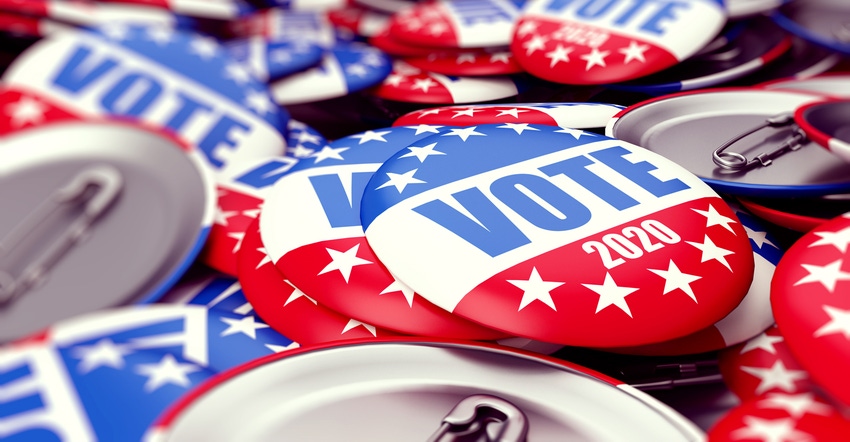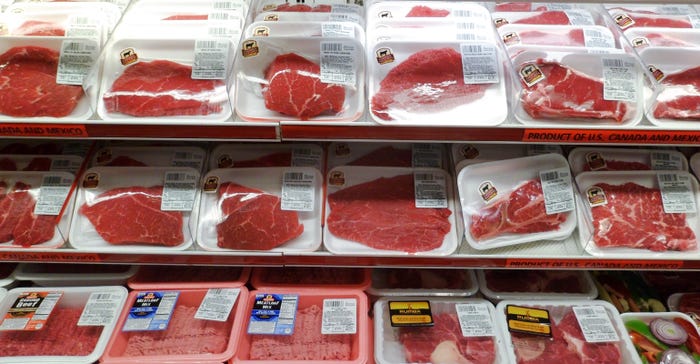March 23, 2020

Many U.S. citizens feel 2020 presidential candidates have yet to address what they, the voters, care about regarding food and agriculture. President Donald Trump’s 2018-19 farm bailout, which didn’t route through Congress, and the prices below the cost of production that caused the U.S. dairy crisis refocus the public’s attention on federal farm subsidies and price supports.
It’s the kind of attention agriculture may not want, and changing market conditions also bring in new issues. As the election approaches, understanding what key advocacy groups are saying about agriculture can be an early heads-up on the issues you may be hearing more about, from crop payments to the challenge of country-of-origin labeling. While COVID-19 may be top of mind these days, the issues covered here offer a peek at some of the ag-focused arguments hitting debates as November nears.
Farm payments
Many U.S. voters, from ag producers to policy analysts, say the farm subsidy system that was established in the 1933 Agricultural Adjustment Act needs reform. In 2019, U.S. taxpayers paid more than $22 billion in farm subsidies. More than half of this, $14 billion, was Trump’s trade compensation to commodity farmers — those that grow corn, soybeans, wheat and cotton — affected by his administration’s trade war with China.
The payment metric for Trump’s farm bailout and the farm safety-net subsidies awards the highest amounts to the largest and wealthiest producers. A 2017 USDA Economic Research Service report showed that one-third of the 2015 farm subsidy payments went to farm businesses with at least $1 million annual sales. Those with less than $350,000 in annual sales — 90% of farm businesses — received only 30% of the subsidy payments. Farmers with household incomes over $146,000 received half of the payments, which is more than twice the U.S. median incomes of $61.937.
The 2020 presidential candidates, including Trump, mostly support farm subsidy programs. This was highlighted when, in March 2020, vegan Direct Action Everywhere activists stormed the stages of two candidates’ rallies — Biden and Sanders — in California to protest federal price support of the dairy industry.
Former Vice President Joe Biden supports farm subsidies for small and midsized farms but has not articulated how he will lead reform. He does propose expanding the Obama-Biden administration’s microloan program for new, beginning farmers, doubling the maximum loan amount to $100,000 per farmer.
Working on payments
Sen. Bernie Sanders, I-Vt., pledges to direct farm subsidies to small and midsized producers, institute a commodity supply management system and reverse corporate consolidation in agriculture. He introduced the 2009 amendment (approved by the Senate) to the agriculture appropriations legislation to increase — by $350 million — the federal dairy surplus purchases.
Sanders and Sen. Patrick Leahy, D-Vt., proposed a dairy supply management program that same year. In 2018, Sanders introduced a bill to provide another $556 million in emergency dairy payments. Both of these are in addition to the annual USDA net removal of dairy products. In one such surplus purchase in 2016, the USDA bought $20 million worth of cheddar cheese.
Trump has yet to declare an official position on farm subsidies for the 2020 presidential election. The American Enterprise Institute reports that Trump’s fiscal year 2020 budget proposed reducing crop insurance subsidies from 62% to 48% of the premiums for their coverage. Additionally, Trump proposed that farm owners and operators with adjusted gross incomes that average $500,000 or more over the previous three years would be ineligible for crop insurance subsidies.
While Trump pushed his budget savings within crop insurance programs, he substantially increased the Market Facilitation Program payments. This doubled farm subsidies in 2019. The Environmental Working Group’s subsidy analysis shows that those payments favored larger producers, says Sarah Graddy, EWG communications director.
“One Missouri farm received $2.8 million,” Graddy observes. “The MFP payments were distributed based on landowners’ acres of commodity crops and not the actual impact of China’s tariffs on U.S. farmers’ income.”
EWG works hard to draw attention to any payments farmers receive and is noted for its work to expose individual farm payments.
Farm payments and crop insurance support are not the only items on the radar for outside observers of agriculture. The idea of country-of-origin labeling continues to bubble up.
What’s in a label?
Some producer and consumer groups have called for mandatory federal country-of-origin labeling of meat products for more than a decade. The 2008 Farm Bill enacted COOL, but Mexico and Canada successfully challenged it at the World Trade Organization. Livestock often move across borders, and Mexico and Canada argued that U.S.’s COOL violated WTO labeling rules.
“An animal, say a cow, will be born in Mexico, and then raised and processed here in the U.S.,” explains Ben Lilliston, director of rural strategies and climate change at the Institute for Agriculture and Trade Policy. “Under COOL, the meat must be labeled where it was born, finished, and processed.”
Lilliston asserts that officials in both Canada and Mexico know COOL rules will give them a competitive disadvantage, because “U.S. consumers want to support U.S. farmers.” Within its own borders, Canada requires all prepackaged food products, including imported meat products, to be labeled with the country of origin.
There were pushes to add mandatory COOL in the 2018 Farm Bill and the recent renegotiation of the North American Free Trade Agreement, but both times the Trump administration declined to include it. “I think this shows the political power that global meat companies hold in the U.S.,” Lilliston comments. “These companies do not want COOL, because they want to move animals and meat across borders for the cheapest price they can find, and sell it without origin labels.”
 LABEL CONFUSION: The push for country-of-origin labeling continues, but so far the Trump administration has not made an effort on the matter, and has opened the market further to Brazilian beef. (Richard Levine/Getty Images)
LABEL CONFUSION: The push for country-of-origin labeling continues, but so far the Trump administration has not made an effort on the matter, and has opened the market further to Brazilian beef. (Richard Levine/Getty Images)

Origin loopholes
When the U.S. repealed COOL following the WTO ruling, it became possible for an animal to be raised in another country and slaughtered into halves or quarters, then its meat shipped to the U.S. for final processing, and the final meat product labeled, “product of the U.S.” For instance, Australian lamb meat often arrives in refrigerated shipping containers after a two- to three-week journey for its final processing and consumer packaging in the U.S.
Recently, the U.S. lifted its ban on raw beef from Brazil. Imports were suspended in 2017, after the U.S. Food Safety and Inspection Service found meat that contained blood clots and lymph nodes in one of its intermittent inspections. In February, ahead of Brazilian President Jair Bolsonaro’s March visit with Trump, the U.S. declared Brazilian beef safe for importation.
It is for food safety and “buy American” reasons that 89% of Americans favored country-of-origin labeling in a 2017 Consumer Federation of America poll. With the Trump administration unwilling to challenge WTO or negotiate with Mexico and Canada on the issue, several states — Colorado, Montana, New Mexico, Iowa and Missouri — have proposed COOL regulations within their respective jurisdictions.
With the election nearing, it’s about issues critical to your operation. No matter your feelings on MFP payments or how meat is labeled, keeping up on the policies of key candidates is key. Top-of-mind issues going into the 2020 election may change as November nears, but crop insurance, price supports and even labeling issues — from COOL to the definition of “meat” — may become issues to follow.
Hemken writes from Lander, Wyo.
About the Author(s)
You May Also Like




